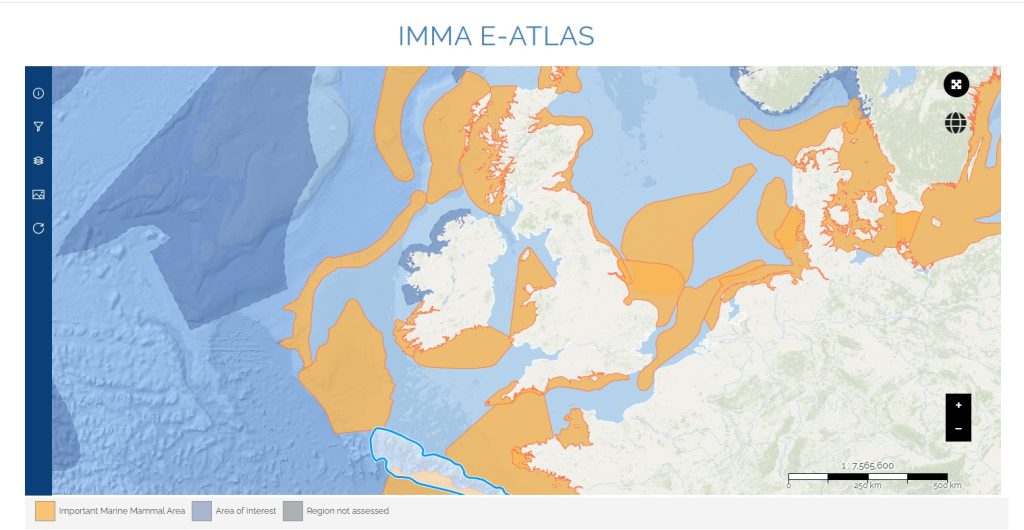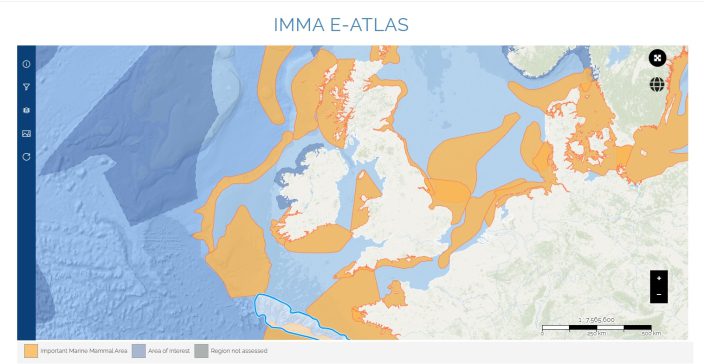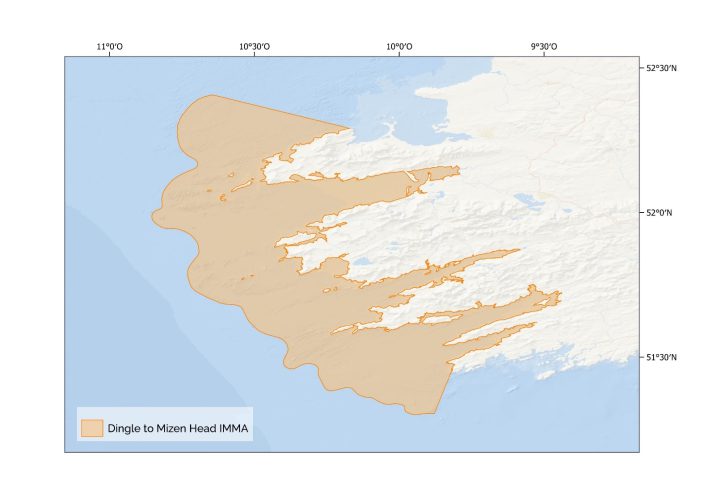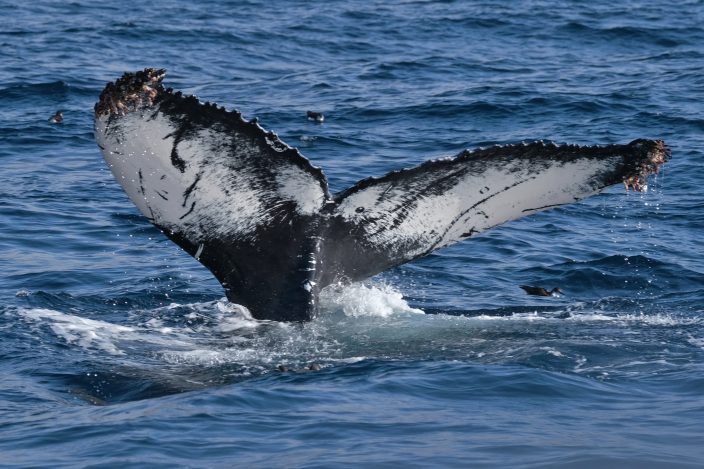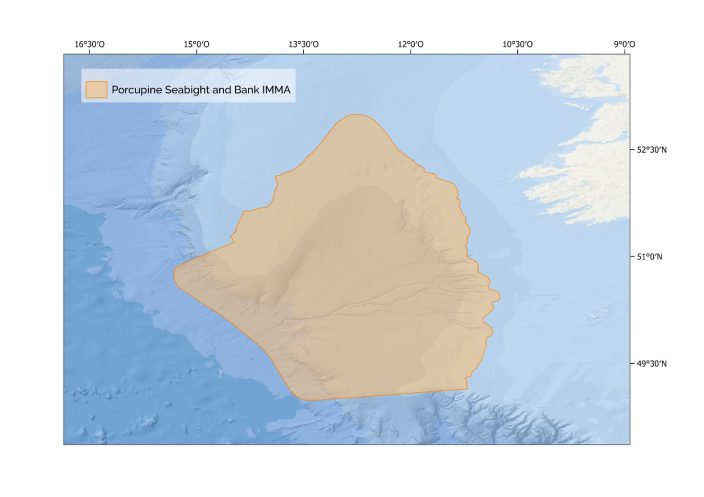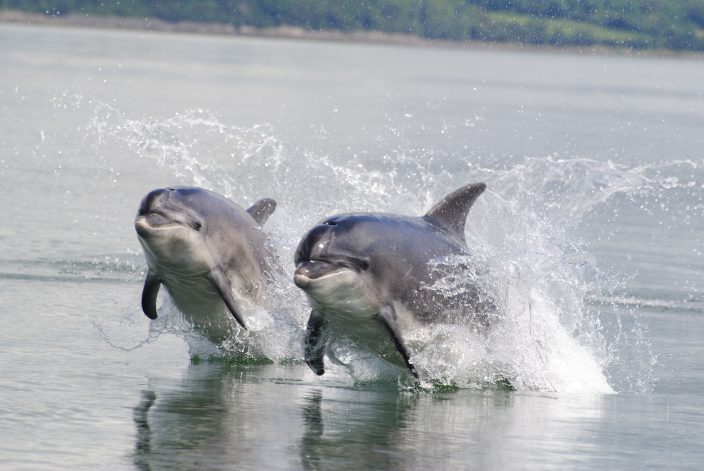The IUCN Marine Mammal Protected Areas Task Force is pleased to announce today the creation of six new Important Marine Mammal Areas, called IMMAs, which include Irish waters and three additional Areas of Interest (AoI). The newly approved IMMAs represent the final result of a full-year process, including an intensive week-long scientific workshop assessing and presenting data on candidate IMMAs which were then submitted for peer review.
IMMAs are defined as discrete portions of habitat, important to marine mammal species, that have the potential to be delineated and managed for conservation. They are not legal designations but independent, peer-reviewed assessments based on a set of criteria supported by data. As a result of this process, a total of 33 new IMMAs in the North-east Atlantic have been added to the IMMA e-Atlas and are now available for download as shapefiles with associated information. Nine areas have been assigned Area of Interest status, spotlighting promising areas in need of more research.
To date, 74.3% of the world ocean has been examined for suitability to be included as IMMAs, with IMMAs now comprising 13% of the examined area. IMMAs are divided into 57% within exclusive economic zones (EEZs) and 43% in international waters on the high seas. Globally, there are now 280 IMMAs and 185 AoI.
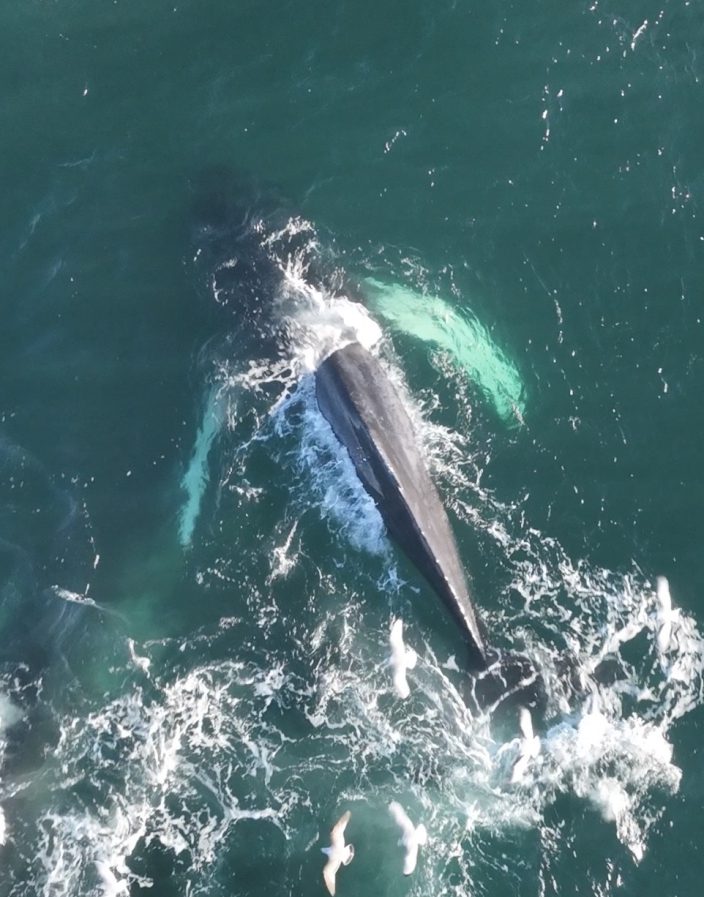 The North East Atlantic Ocean and Baltic Sea (NEATLO) Region covers nearly a quarter of the Atlantic Ocean. Species rich, the region offers essential habitat for feeding and migrating humpback whale, blue whale and fin whale. There is deep water habitat for Cuvier’s and other cryptic beaked whale species in the offshore waters in the region. Species involved in protective measures include the minke whale, harbour porpoise, common dolphin, Risso’s dolphin, bottlenose dolphin and harbour seal. There are several populations of killer whales including the critically endangered Strait of Gibraltar subpopulation with only 39 individuals subsisting on bluefin tuna and lately disabling or breaking the rudders off small boats traversing the region.
The North East Atlantic Ocean and Baltic Sea (NEATLO) Region covers nearly a quarter of the Atlantic Ocean. Species rich, the region offers essential habitat for feeding and migrating humpback whale, blue whale and fin whale. There is deep water habitat for Cuvier’s and other cryptic beaked whale species in the offshore waters in the region. Species involved in protective measures include the minke whale, harbour porpoise, common dolphin, Risso’s dolphin, bottlenose dolphin and harbour seal. There are several populations of killer whales including the critically endangered Strait of Gibraltar subpopulation with only 39 individuals subsisting on bluefin tuna and lately disabling or breaking the rudders off small boats traversing the region.
Western European countries have at their disposal a broad suite of spatial conservation measures, not only national efforts to make marine protected areas (MPAs), but EU Habitats Directive Special Areas of Conservation, OSPAR agreement MPAs, International Maritime Organisation (IMO) designations and routing, and marine spatial planning both through the EU Marine Strategy Framework Directive and efforts at the national and local level.
“IMMAs may seem redundant in European and North East Atlantic waters,” says Erich Hoyt, co-chair of the IUCN Marine Mammal Protected Areas Task Force. “But, in fact, IMMAs provide a check to see if marine mammal habitats are included under existing measures. At the same time, IMMAs are turning up substantial new areas which are needed for protection.”
The week-long North East Atlantic IMMA workshop, held in Hamburg, Germany, in May 2023 which the IWDG attended, was supported by a grant from the Water Revolution Foundation. The meeting was organized by the IMMA Secretariat of the Task Force. The 53 workshop participants from 13 countries were drawn from the region’s top marine mammal scientists. They started by considering 395 preliminary areas of interest (pAoI). The pAoI selected to advance to candidate IMMAs were then defended with text supporting various criteria based on scientific evidence and detailed mapping along with a strong rationale for the boundaries chosen. After an extensive review process, the mapping of these areas is now complete.
“We are turning the corner in terms of government, industry and academic recognition of the value of IMMAs,” says Task Force co-chair Giuseppe Notarbartolo di Sciara. “As we get closer to completing the global picture, IMMAs are now securing a place for whales and other marine mammals at the negotiating table for ocean conservation measures.”
The IMMAs in Ireland that have been agreed by the IUCN are:
- Porcupine Seabight and Bank IMMA
- Dingle to Mizen Head IMMA
- Southeastern Rockall Slope and Canyons IMMA
- Celtic Sea IMMA
- Rockall Trough Seamounts and Banks IMMA
- The Shannon (Sionna) Approaches IMMA
Together with three Areas of Interest including Malin Head to Clew Bay AoI, Rockall and Hatton Banks AoI and Galway Bay AoI, which though identified as important require more data to be considered a full IMMA.
The IWDG worked on three of the successful IMMAS, while our colleagues in the UK worked on the Celtic Sea, Rockall Trough and Southeastern Rockall Slope IMMAs with IWDG input.
The southwest peninsulas have been included in the Dingle to Mizen Head IMMA due to the habitats and currents that support a rich diversity of marine mammal species including minke whale aggregations, seal breeding areas and regular humpback whale feeding. The Porcupine Seabight and Bank IMMA provides important habitats for blue and fin whale which are vulnerable species still recovering from whaling. In addition, the diversity of marine mammal species from long-finned pilot whale to Sowerby’s beaked whale is also recognized, with upwellings along the shelf break, providing a rich source of nutrients. The Shannon (Sionna) Approaches IMMA extends the Special Area of Conservation which was established to protect the genetically unique locally resident bottlenose dolphin population, which have been the subject of intensive research, while the IMMA extends the areas to all areas important for the survival of this population which have recently extended their range most likely to find prey.
Patrick Lyne of the IWDG who attended the workshop “Those areas which are now accepted as IMMAs will require further study, monitoring, and where possible protective measures, but the IMMA label confers considerable international scientific recognition”.
This work between the IWDG and the IUCN will assist Ireland in identifying important areas for marine mammals that should be consider as Marine Protected Areas under new legislation coming to the Dail this year.
To obtain shapefiles and detailed background information for the 280 IMMAs, go to https://www.marinemammalhabitat.org/immas/imma-spatial-layer-download/
Notes for Editors
- The IMMA initiative is a partnership between the IUCN Joint SSC-WCPA Marine Mammal Protected Areas Task Force, Tethys Research Institute and Whale and Dolphin Conservation (WDC). A recent paper in Frontiers in Marine Science details the Task Force IMMA work (2016-2022): https://www.marinemammalhabitat.org/download/the-important-marine-mammal-area-network-a-tool-for-systematic-spatial-planning-in-response-to-the-marine-mammal-habitat-conservation-crisis/
- The work of the Task Force for its IMMA initiative has been financed mainly by the International Climate Initiative (IKI) of the German Federal Ministry for the Environment, Nature Conservation, Building and Nuclear Safety (BMUB) as part of the Global Ocean Biodiversity Initiative (GOBI). Individual regions have been funded by the French Biodiversity Agency through the IUCN Marine and Polar Programme and by the MAVA Foundation with timely assistance by the Animal Welfare Institute and others. The funding for the North East Atlantic Ocean and Baltic Sea IMMA region came from the Water Revolution Foundation with assistance by OceanCare and orca.org, both of which sent participants to the workshop.
- The global total of IMMAs now stands at 280, with an additional 185 areas of interest (AoI). The e-Atlas showing maps of all the IMMAs and Aoi identified to date is here: https://www.marinemammalhabitat.org/imma-eatlas/
- Area of Interest or AoI status is not as strong as IMMA status but it is valuable in terms of facilitating and focusing future monitoring and research activities on marine mammals in the region which may in future help turn it into an IMMA.
- This media release and a final report of the North East Atlantic Ocean and Baltic Sea IMMA region are available for free download on the marinemammalhabitat.org website: https://www.marinemammalhabitat.org/resources/documents/
For more information, story leads, contacts and use of photos and maps,
email Task Force co-chair: Erich Hoyt, erich.hoyt@imma-network.org
For more information on IMMAs in Ireland contact:

